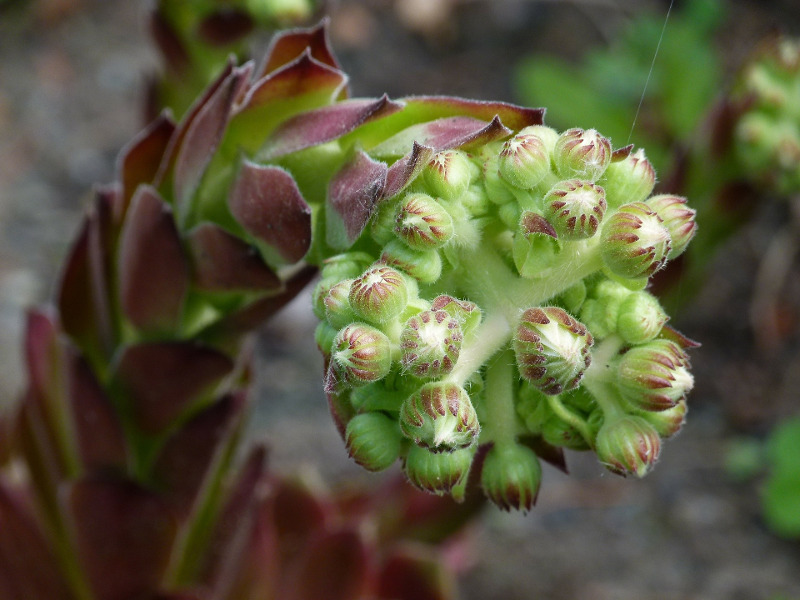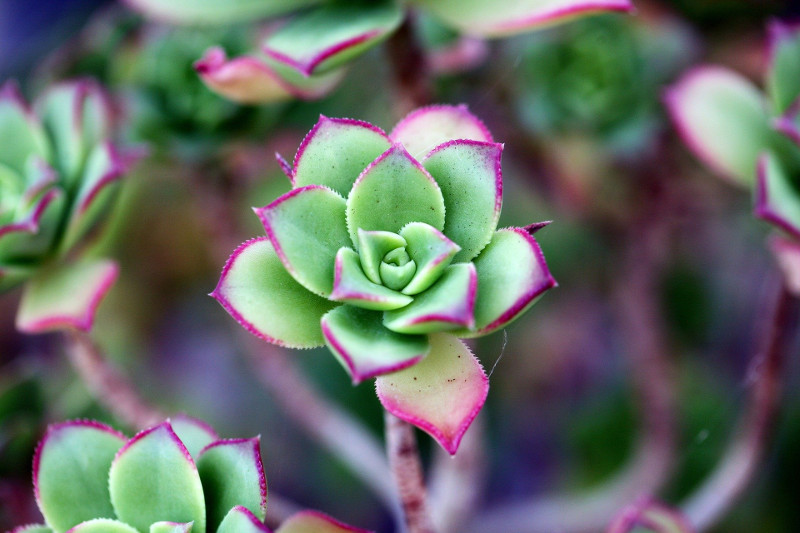Hens and chicks, which have attractive, fleshy leaves in a rosette shape, will send up a long stalk that produces small flowers. But don't expect your hens and chicks to bloom immediately or every year. Only mature plants (three or more years old) tend to bloom, and often, conditions favor blooming in some years better than others, especially for hens and chicks that live outside all year. When it is time for the plant to bloom, it typically does so in summer when long, warm, sunny days support flower production.

When a hens and chicks flower stalk forms, it can cause some concern at first, since the bloom stalk can look like a bulge or strange stem that doesn't match the uniform growth of the plant's leaves. But keep an eye on that bulge or tall, growing center of the plant. It's likely a flower stalk that eventually produces pretty little star-shaped blooms. Signs your hens and chicks plant is about to bloom include closing of the center's leaves, that stretching main stem, or a tilted appearance to the rosette.
Why Are Hens And Chicks Growing Tall?
When a hens and chicks plants begin to bloom (often times called a "rooster"), the mature center of the plant will begin to grow tall and elongate. These typically low growing plants can all the sudden grow up to a foot tall. This process is known as the monocarpic process, and signals that the mature center of the plant is about to flower, produce seeds, then die off.
Not to worry though, because the plant should have created several smaller rosettes before starting this process, ensuring the plants will not only live on, but spread and grow even bigger than before.

Cutting the stem off won't save the plant. So you might as well let the rosette bloom and enjoy the unique and beautiful flowers it produces!
Sometimes, hens and chicks get tall, or "leggy" because they are not receiving enough light and the plant is reaching in search of light. The stem from a leggy, light-deprived plant will look fairly weak and bare. A flower stalk will look rounder and lusher, with upward-facing bud clusters.

Here is an example of a hens and chicks plant that is "leggy", not about to bloom.
Does Pruning Help Hens and Chicks Bloom?
Pruning or dividing your hens and chicks won't necessarily produce blooms. Just give the mature center rosette (or hen) time and it eventually should flower before it dies. You can keep the hen healthier, however, by dividing the plant if the offshoots (chicks) begin to grow into or over the hen (blocking the light going to the mature center). Just remove and repot the crowded chicks to start a new plant.

Does Fertilizing Hens and Chicks Help It Bloom?
Fertilizing won't necessarily force blooming on a succulent like hens and chicks; flowering takes time. But keeping the plant healthy so it continues to grow and reaches maturity after several years can ensure it reaches the flowering stage. This includes applying a diluted natural fertilizer once in spring and once in summer for potted hens and chicks, and less often for those growing outside, depending on the soil quality.
How To Get Hens and Chicks To Produce Blooms?
Just be patient, since you can't force blooms on these succulents. The center of the mature plant typically dies after blooming, so you will only see blooms once in its lifetime. After the blooms fade, pull them off the stalk. The chicks that have rooted become new plants, however, so you don't have to say goodbye to your hens and chicks permanently. Just remove the old hen and watch the chicks mature, eventually covering the space left by the original center and flowering on their own in future years.

How to Know My Sempervivum Is About to Bloom?
- A bulge or stalk forms from the center
- The bulge or stalk appears on a mature hen or center rosette
- Most likely, outdoor plants bloom in summer. Container plants might bloom in late spring or summer, when indoor light increases.
 |
Author Teresa Odle - Published 12-16-2020 |
